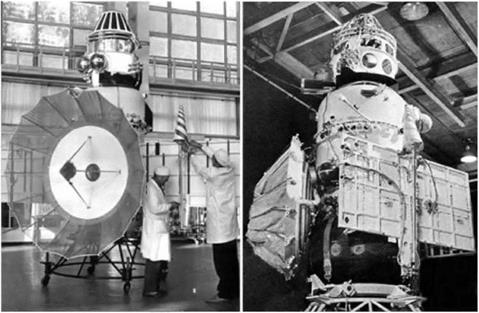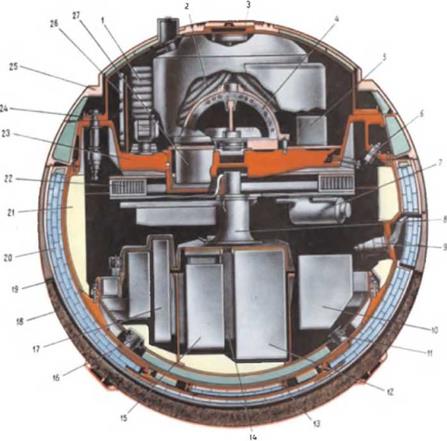FOLLOWING UP AT VENUS: 1969
Campaign objectives:
In 1967 Venera 4 worked as well as could be expected considering the unknown environment to which it was sent. The US had only managed a flyby in this launch window for Venus* while the first successful Soviet planetary mission had achieved the impressive technical challenge of descending through the planetary atmosphere and sending back critical data on its characteristics. Knowing the US had no plans to return to Venus because it desired to focus on Mars, the USSR set out to develop an unassailable lead in the investigation of Venus.
NPO-Lavochkin built two new 3MV spacecraft for the 1969 launch opportunity. Venera 4 w7as high above the surface wlien it fell silent after 93 minutes of descent, either when it was crushed or when the battery ran out. It was decided that the new capsules must fall more rapidly in order to reach a deeper level in the time allowed by the battery. The capsules were similar to that of Venera 4, but modified to endure a higher entry velocity and with a smaller parachute for a faster descent.
|
Spacecraft launched |
|
|
First spacecraft: |
Venera 5 (2V No.330) |
|
Mission Type: |
Venus Atmosphere/Surface Probe |
|
Country і Builder: |
USSR NPO-Lavochkin |
|
Launch Vehicle: |
Molniya-M |
|
Launch Date: Time: |
January 5, 1969 at 06:28:08 UT (Baikonur) |
|
Encoitn ter Dale і 7 ‘і me: |
May 16, 1969 |
|
Outcome: |
Successful. |
|
Second spacecraft: |
Venera 6 (2V No.331) |
|
Mission Type: |
Venus Atmosphere/Surface Probe |
|
Countryi Builder: |
USSR.’NPO-Lavochkin |
|
Launch Vehicle: |
Molniya-M |
|
Launch Date: Time: |
January 10, 1969 at 05:51:52 UT (Baikonur) |
|
Encounter Date/Time: |
May 17, 1969 |
|
Outcome: |
Successful. |
Taken together, data from the Venera 4 and Mariner 5 missions in 1967 and from terrestrial measurements of the planet’s radio brightness indicated that the surface pressure on Venus greatly exceeded the design tolerance of the descent capsule. But the debate about whether Venera 4 had reached the surface raged on for 2 years. In 1968 Soviet and American scientists met first in Tucson in March, then again at the COSPAR meeting in Tokyo in May. and for a third time at a symposium in Kiev in October. The result was general agreement that the surface conditions were 427C and 90 bar. But this long debate did not reach consensus soon enough to influence the short construction schedule available for the 1969 probes. Knowing only that the pressure exceeded 18 bar, NPO-Lavochkin increased the tolerance to 25 bar for the new missions. By the time Venera 5 and 6 were launched, however, it was accepted that the surface pressure was much greater. With no time for further improvement, the missions were treated simply as an opportunity to obtain data using more precise instruments while new higher pressure designs were created for the next window .
Both missions were successful in descending through the atmosphere and. just as expected, the capsules imploded at altitude. The Soviet media had played down any expectations of reaching the surface. Venera 5 and 6 firmly set the stage for the next mission, which would attempt to reach the surface. This was the first 100% success rate for multiple launches and the first 100% success rate for multiple spacecraft.
Spacecraft:
The carrier vehicle was essentially the same as Venera 4, but the descent probe was strengthened to handle the higher velocity of approach in 1969, which would impose a higher deceleration load of 450 G, and also to withstand a pressure of 25 bar. This used up the buoyancy mass allocation. A lower velocity of 210 in. s was preset for the deployment of the pilot parachute, wath smaller parachutes employed to descend more quickly and obtain measurements nearer to the surface before either the battery expired or the internal temperatures became lethal. The pilot parachute was reduced in size from 2.2 to 1.9 square meters, and the main chute from 55 to just 12 square meters.
Figure 11.1 (right) shows the Venera 6 spacecraft folded in launch configuration. The entry system is at the bottom covered with its dark ablation material. Most 3MV pictures are taken with the probe painted white and bearing the letters "СССР’. The antenna and solar panels are folded to fit into the launcher shroud and the spiral gas cooling pipes are visible on the back of the high gain antenna dish which, by facing in the opposite direction to the solar panels, acts as a radiator. The Venera 5 and 6 spacecraft w ere identical.
|
Figure 11.1 Venera 5 on display and Venera 6 folded for launch. |
Payload:
Carrier spacecraft:
1. Solar wind charged particle detector
2. Lyman-alpha and atomic oxygen photometers
3. Cosmic ray gas discharge and solid state detectors
These are the same as on Venera 4.
Descent/landing capsule:
1. Temperature, pressure and density sensors
2. Atmospheric chemical gas analyzers
3. Visible airglow photometer
4. Radio altimeter
5. Doppler experiment
Atmospheric density was measured during entry by a combination of Doppler tracking and the probe’s accelerometers. In the parachute descent the atmospheric structure experiment measured temperature, pressure and density. This instrument was improved over Venera 4 with three platinum wire resistance thermometers for more precision, two redundant sets of three aneroid barometers covering the ranges
0. 13 to 6.6 bar, 0.66 to 26 bar and 1 to 39 bar, and a tuning fork densitometer for the
|
Figure 11.2 Venera 5 and Venera 6 entry capsule diagram: 1. Drogue parachute; 2. Main parachute; 3. Pyro piston lid; 4. Transmitter antenna; 5. Density sensor; 6. Gas fill valve; 7. Deliumidifier; 8. Thermal control fan; 9. Pressurization valve; 10. Commutation block; 11. Accelerometer; 12. Transmitter; 13. Oscillation damper; 14. Battery; 15. Redundant transmitter; 16. Accelerometer; 17. Timer; 18-20. External insulation; 21. Internal insulation; 22. Thermal control system; 23. Lander cover; 24. Pyro piston; 25. Parachute compartment lid; 26. Radio altimeter antenna; 27. Gas analyzer. |
wider range of 0.0005 to 0.040 g/cc. The atmospheric gas analyzers were improved and reconfigured to benefit from the experience of Venera 4. A getter was added to measure the total inert gases including molecular nitrogen, and refinements were introduced to make better measurements of molecular oxygen and water. Accuracies were improved by transmitting a pressure reading at the same time as a composition analysis. Venera 5 would make its composition measurements at higher altitudes and Venera 6 at lower altitudes. A number of improvements were made to the radar altimeter to avoid the problems on Venera 4, and three semaphores were provided for altitudes of 45, 35, and 25 km at an accuracy of about 1.3 km. Even though these were night-lime landings, a visible photometer was included to measure light levels during the descent because the dark hemisphere of the planet was known to exhibit an airglow phenomenon of unknown origin.
Mission description:
Venera 5 was launched on January 5, 1969, performed a course correction maneuver on March 14 when 15.5 million km from Earth, and reached Venus on May 16. The entry capsule was released at a distance of 37,000 km and at 06:01 UT it entered the atmosphere at 11.17 km/s at an approach angle of 65 degrees. During the parachute descent at 3°S 18°E on the night side, it provided a set of instrument readouts every 45 seconds for 53 minutes. The transmission ceased at an altitude of about 18 km when the pressure exceeded 27 bar. At that time the external temperature was 320 :C and internal temperatures had reached 28 C. It was 4:12 Venus solar time and the solar zenith angle was 117 degrees.
Venera 6 was launched on January 10, 1969, conducted a midcourse correction on March 16 at 15.7 million km, and arrived on May 17 (one day after its partner). The entry capsule was released at a distance of 25,000 km and it entered the atmosphere at 06:05 UT. It descended over 5 S 23 E on the night side and transmitted for 51 minutes. Signals ceased at an altitude of about 18 km and a pressure of 27 bar, thereby confirming the results from its partner. It was 4:18 Venus solar time and the solar zenith angle was 115 degrees.
The Venera 5 and 6 carrier spacecraft both provided measurements on the upper atmosphere and ionosphere prior to breaking up in the atmosphere.
Results:
The Venera 5 and 6 entry capsules transmitted in excess of 70 temperature readings and 50 pressure readings during the descent from about 55 km altitude to their crush depth. Atmospheric density was derived from the temperature and pressure data by using the hydrostatic equation and verified against parachute descent characteristics inferred from the radio altimeter. Doppler data provided altitude profiles of wind speed and direction, both horizontal and vertical. While there was initially confusion about the altimetry, these instruments did work properly and the temperatures and pressures measured near the radio altimeter marks were a good match to the current engineering model of the planet’s atmosphere:
|
Venera 5 Venera 6
|
Each capsule made two readings of atmospheric composition: at 0.6 and 5 bar for

 |
Venera 5. and at 2 and 10 bar for Venera 6. Their readings were consistent and in good agreement with the Venera 4 data:
Neither photometer registered anything except darkness, although the photometer on Venera 5 did report a large reading just before termination. This eould have been a flash of lightning but. given the timing, it may merely have been an electrical transient caused by the imminent breakup.
The Venera 5 and 6 carrier spacecraft returned measurements on the solar wind in the vicinity of Venus and its interaction with the planet.












